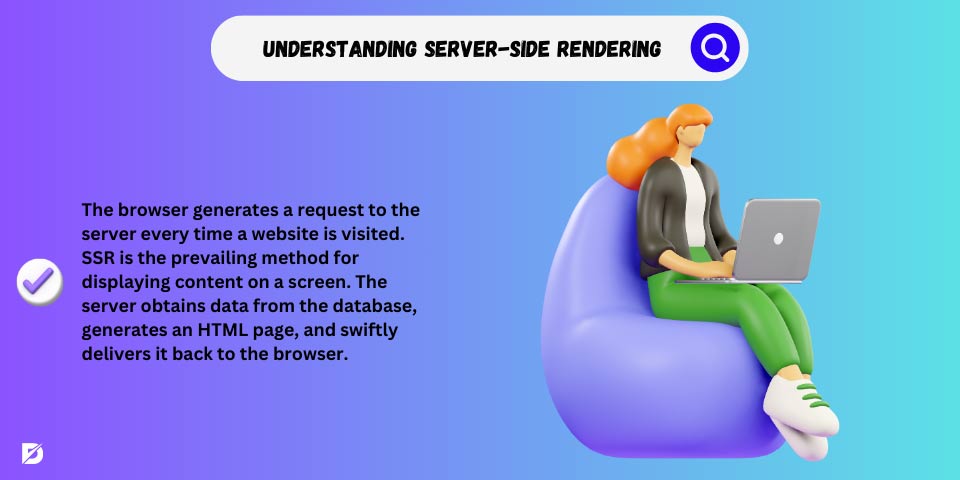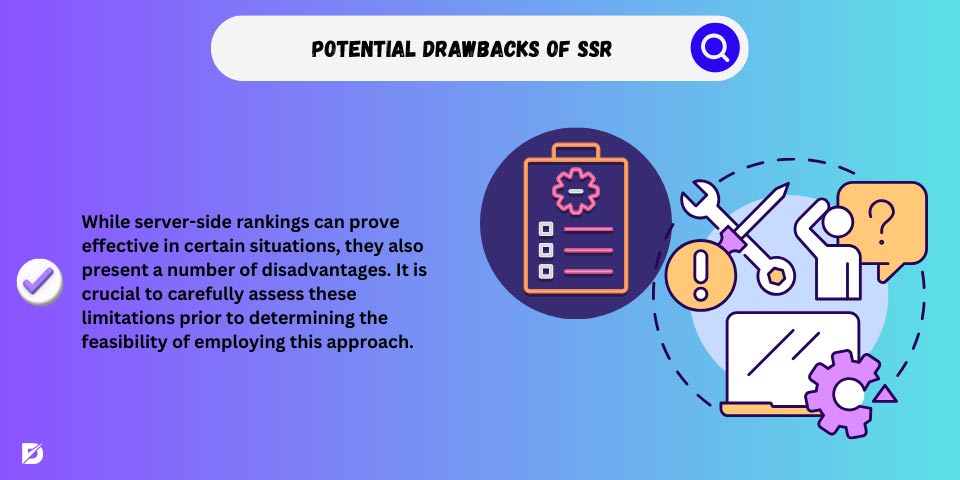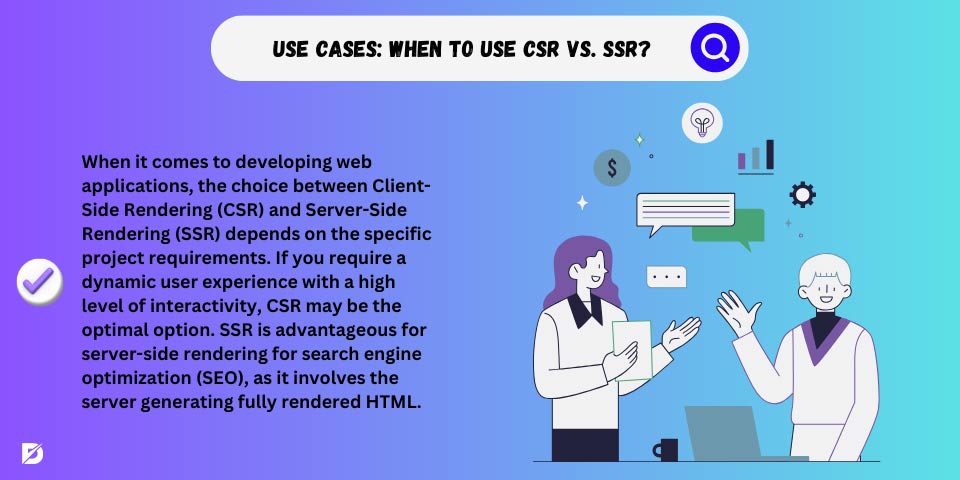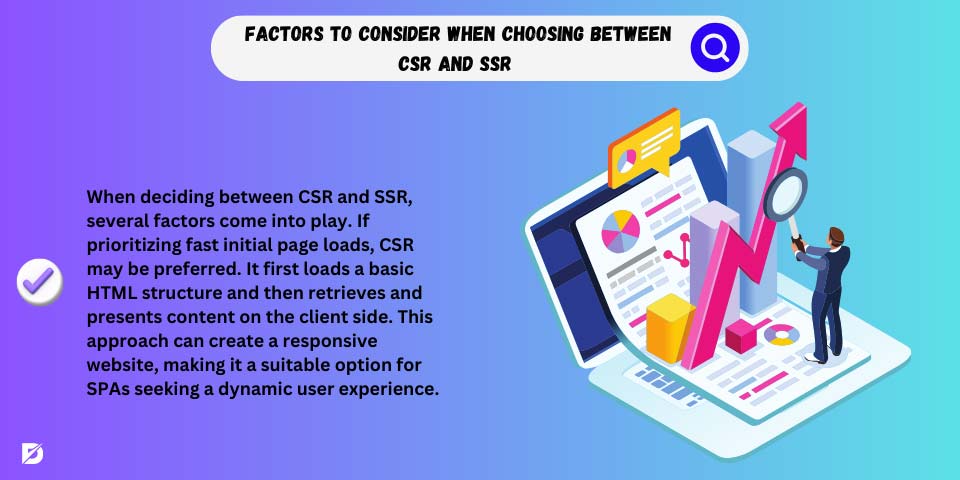Efficient website load times enhance user experience and search engine optimization (SEO). When determining a website’s Google ranking, the speed at which it loads is critical. A front-end web developer must carefully choose the optimal rendering technique to give users a fast and dynamic experience. Two commonly used rendering methods are client-side rendering (CSR) and server-side rendering (SSR). However, as every website has unique requirements, it is essential to understand these two approaches’ differences to decide which best suits your business objectives.
Basics of Web Rendering
Rendering is a crucial web development technique that involves converting website code into interactive pages people see when visiting a website. This process typically consists of using HTML, CSS, and JavaScript codes. A rendering engine, software employed by a web browser, plays a pivotal role in the entire process by rendering the web page and providing an immersive user experience.

What Is Rendering?
As search engines like Google analyze and interpret the content and structure of a web page, they engage in a process known as rendering. This process helps determine how a web page should be indexed and ranked in search results.
How Web Pages Are Displayed
The internet uses protocols to facilitate communication between a vast network of computers. FTP is a primary method for sending files between a client and a server. A web page is a file containing data and style components hosted on web servers. To access a web page, the client software must request the file from the server and interpret its markup for display on the client’s computer or device.
Dive Into Client-Side Rendering
Client-side rendering for websites is a modern technique that has gained popularity with the incorporation of JavaScript libraries. This method involves having your browser render the website’s JavaScript instead of relying on the server to do so. Instead of receiving all the content from the HTML document, the server sends an essential HTML document that includes the JS files.
How Client-Side Rendering Works?
Thanks to client-side rendering, developers can use JavaScript to render their websites in the browser fully. By creating each route dynamically in the browser, a client-side generated website eliminates the need for separate HTML pages for each route. Once JS frameworks made it simple to adopt, this strategy gained traction.
Advantages of Client-Side Rendering
CSR and SSR are two popular methods of rendering online content. With CSR, most online content processing and rendering takes place on the client’s device. On the other hand, SSR creates the HTML content and delivers it to the client’s browser on the web server. The usage of client-side rendering has the following benefits:
Interactivity and Single Page Applications
When it comes to website development, client-side rendering can have a crucial effect on the total user experience. While it can enhance the site’s responsiveness and interactivity, it can also result in longer initial load times and heavier resource usage on the client’s web browser. Thus, it’s essential to carefully consider the pros and cons of client-side rendering before implementing it in a website.
Reduction In Server Load
Client-side rendering offers a range of advantages, including faster loading speeds and improved SEO performance. This leads to faster load times and maybe higher search engine results because the server does not have to parse and render the website or web application each time it is requested. Moreover, such website performance improvements can significantly enhance the overall user experience.

Understanding Server-Side Rendering
The browser you use generates an inquiry to the server whenever you visit a website. The most common technique used for projecting content onto a screen is SSR. The server retrieves data from the database, creates an HTML page, and sends it back to the browser in just a few milliseconds.
The Mechanism Behind SSR
The server generates each page as a static HTML file by utilizing this method. This enables the page to be updated dynamically as needed, resulting in a seamless and streamlined user experience.
Advantages of Server-Side Rendering
To list the benefits of using server-side rendering, we can start with the following:
Improved SEO
To ensure that web pages are easily crawled and indexed by search engines, it’s important to provide HTML content. SSR is a technique that is useful for rendering pages on the server. By doing so, the content can be more readily accessed by users.
Faster Initial Page Load
As web pages are rendered on the server and sent to the client as fully formed HTML pages, the client’s time required to generate the page is reduced. This enhances the user’s experience and boosts search engine rankings significantly.

Potential Drawbacks of SSR
Although server-side rankings can be effective in some cases, they also come with several drawbacks. Considering these limitations before deciding whether to use this method is important. Let’s take a closer look at some of the main drawbacks of server-side rankings:
Server Load and Scalability
When a website is rendered using server-side rendering (SSR), the server has to use additional resources to handle the rendering process. As a result, this can lead to increased server load and slower response times for users. Therefore, it’s important to consider the potential impact on server performance when implementing SSR.
Complexities In Development and Deployment
When implementing SSR, it’s important to consider the additional development and maintenance efforts required. This can add complexity to the development process, potentially increasing development time and project costs.

Use Cases: When to Use CSR vs. SSR?
When developing web applications, whether to use CSR or SSR depends on the project’s specific requirements. CSR may be the best choice if you need a high level of interactivity and a dynamic user experience. With SSR, the server generates fully rendered HTML, which is beneficial for server side rendering for SEO. Additionally, it provides a fully rendered page for the initial load, which can be faster for users on slower connections.
Interactive Web Apps and SPAs: A Case for CSR
In the context of CSR, the typical flow involves the browser making an initial request to a CDN rather than the server. The CDN then sends a base ‘wrapper’ that contains all the static HTML, CSS, and supporting file elements of a web page or application. This approach enables faster load times for users and a more seamless browsing experience.
E-Commerce And Content-Heavy Websites: Why SSR Makes Sense?
Server-Side Rendering (SSR) is a powerful technique that improves SEO and user experience by rendering web pages on the server before sending them to the client. SSR speeds up websites, improves interoperability, enables server-side caching, and promotes web accessibility for all users.
Hybrid Approaches: Combining CSR and SSR
Online applications can combine client-side and server-side rendering to provide a faster user experience. The server can quickly deliver content to the user by rendering a pre-rendered page. Additionally, combining client-side routing, real-time updates, and interactivity after hydration can provide a seamless and dynamic user experience. This approach also allows for reusing code and parts across the client and server, minimizing duplication and improving maintainability.
Concluding Thoughts and Future Trends
Due to the fast-paced nature of web development, deciding between CSR and SSR, or a hybrid approach, will always depend on the specific project objectives and goals. To ensure that you stay up-to-date with the latest developments, it’s essential to keep an eye on blogs. Ultimately, staying up-to-date with the latest trends and developments can help you stay ahead of the curve in your web development projects.

Factors To Consider When Choosing Between CSR And SSR
The choice between CSR and SSR depends on a variety of factors. If quick initial page loads are a priority, CSR may be the way to go, as it loads a bare HTML shell before fetching and rendering content on the client side. This can result in a faster-feeling website, making it a logical choice for SPAs that require a dynamic user experience.
On the other hand, SSR may be a better option for websites that require quicker page loads in the future and perform better on sluggish connections. Additionally, if the functionality and content of your website are more straightforward or don’t require a lot of client-side processing, SSR could make development and maintenance easier.
Overall, understanding the differences between CSR and SSR and their respective advantages and disadvantages can help you make an informed decision about which approach is best suited for your website.
The Rise of Serverless Rendering and Edge Computing
Serverless rendering can be installed at edge locations to deliver dynamic content rendering and processing closer to end users. Applications that require content creation and real-time interaction may find this combination very useful.
When these two trends are combined, serverless rendering and edge computing can create a strong foundation for contemporary and low-latency applications. They offer effective and scalable methods for managing web content and applications.
Frequently Asked Questions About
Thanks to client-side rendering, developers have the ability to render their websites in the browser using JavaScript fully. With the ability to create each route dynamically, a client-side generated website eliminates the need for separate HTML pages for each route.
When it comes to web development, developers can pre-populate a web page on the server with unique user data by using server-side rendering. This process ensures the web page is ready to go, providing a seamless and efficient user experience.
When a user requests a different route, client-side rendering handles the routing dynamically without requiring a page refresh. However, it is important to note that client-side rendering may show a blank page initially, as it needs to fetch the necessary data before rendering the page. Server-side rendering can provide a seamless user experience by displaying a fully populated page on the first load for any website route.





No comments to show.